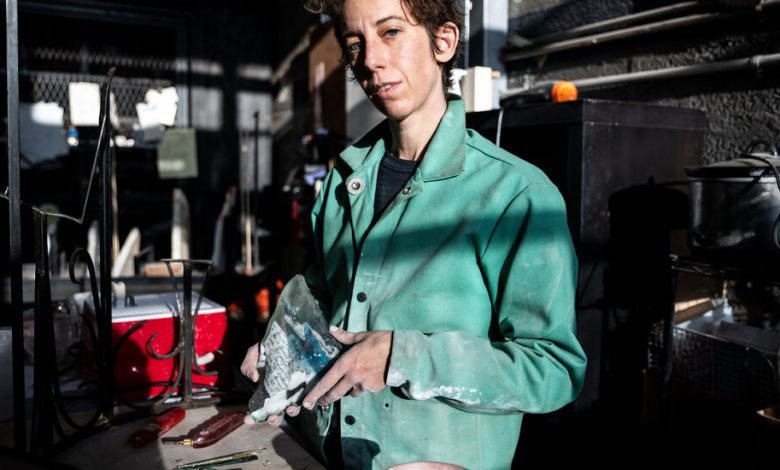You Didn’t Have to Be Famous to Be Buried at Green-Wood

Good morning. It’s Thursday. We’ll look at an artist who focused on less-than-famous sections of a famous cemetery in Brooklyn. We’ll also find out why some officials consider City Hall’s reaction to last month’s wildfire smoke sluggish.

Credit…Maria Baranova via Green-Wood Cemetery
Many well-known people are buried at Green-Wood Cemetery in Brooklyn, among them the artist Jean-Michel Basquiat, the conductor Leonard Bernstein, the political-machine operator Boss Tweed and the 19th-century composer Louis Moreau Gottschalk (who collapsed while playing one of his own pieces, “Morte,” or “Dead”).
They were not the ones who intrigued Rowan Renee, until recently Green-Wood’s artist in residence. Renee wanted to know about people no one remembered — working-class or poor people, many of them Black, who had been buried on the edges of the cemetery in what were known as the public lots.
From Renee’s research, and from preserving fragments of marble and glass that Renee collected, Renee created an exhibition called “The Perimeter Path” that is on display in Green-Wood’s chapel and documents how race and class influenced the cemetery’s very landscape. Green-Wood says the exhibition “was conceived as an act of care for those at the margins of our collective memory.”
“What’s so great about Rowan’s project is, people come to see Bernstein’s grave or Basquiat’s, but what are the stories of these people who seem to have vanished?” said Harry Weil, the vice president for education and public programs at the cemetery. “How can we weave their stories into our tours?”
Of the 570,000 burials since Green-Wood was founded in 1838, just over a third were in public lots or “single-grave areas” where gravesites were cheaper than in privately owned plots or in mausoleums or columbaria.
“The people who are buried in the public lots were looking for affordable,” Weil said. In 1895, a single grave in a public lot cost $31 for an adult. The prices for private lots varied; the smallest had three graves and cost $160 to $220. The largest, with 15 graves, went for as much as $1,200.
Renee said it wasn’t just the prices that set the public lots apart: The sense of place was different, because there were few signs of the burials that had taken place there. “When you’re in the middle of Green-Wood, it envelops you and the city disappears — you’re in this gorgeous other world,” Renee said — a well-populated, well-tended universe. In public lots around the edges of the cemetery, “there was a lot of empty space. I was like, ‘Where are the tombstones? What happened to them?’”
Renee found that if tombstones were installed in public lots, “they were installed without a foundation.” This kept the cost down but left the tombstones vulnerable: They could topple over later on. When that happened, “the grass grows over them and they are sucked into the earth,” Renee said.
One of the lots Renee focused on was Public Lot 88, which was among “freedom lots” that were designated for Black New Yorkers. Renee said many of those interred there had been born enslaved, both in the South and the North. Among them was William Russell Johnson, who Renee said had been active in Democratic politics in Brooklyn in the late 19th and early 20th centuries.
Weil said the lack of information about some of those buried in the public lots served as a counterpoint to the well-known biographies of the famous (or, in Tweed’s case, the infamous). He mentioned Carl Johan Heidenreich and Bernhardt Forsst, who Renee’s work showed had been buried in one grave. Weil said it’s not clear why; they died five years apart and had no obvious connections. The only record on Forsst that Renee found suggested that he was visiting from Germany. It also said he had drowned at the public baths in the East River, which were platforms that summertime swimmers could jump off.
Heidenreich had immigrated from Norway in the 1860s and, after working as a merchant, became a patient in a mental hospital. It was not clear what caused his death. His death certificate listed “melancholia,” a Victorian term that covered anxiety, depression and psychosis as well as suicidal intent.
“Here’s a grave where you can talk about people who were committed to asylums,” Weil said. “That’s not the story we tell. Having a story like this lets us retell the narrative.”
Weather
It’s partly sunny with temperatures near 90. There’s a chance of showers and thunderstorms in the afternoon persisting through the night. At night, temps will drop to around the mid-70s.
ALTERNATE-SIDE PARKING
In effect until Aug. 15 (Feast of the Assumption).
The latest New York news
Living in the city
-
Public housing: New York City’s public housing agency needs more than $78 billion for repairs and renovations over the next 20 years. That number has grown more than 70 percent since 2017.
-
The mysterious neighbor: After 40 years on the Upper West Side, Sheila Sullivan had seen and done it all: brushed off Frank Sinatra, snubbed Joe DiMaggio and married one of the top stars of the 1960s. Then she got an eviction notice.
More local news
-
Cannabis shop raid: Police officers and tax agents raided the Empire Cannabis Club in Manhattan as part of stepped-up state efforts to crack down on unlicensed dispensaries.
-
Trump-Carroll lawsuit: The Justice Department said it could no longer argue that Donald Trump was acting in his official capacity as president when he insulted the writer E. Jean Carroll — a turnabout that gives new momentum to her case.
-
“Daddy’s Little Meatball”: Tourists and Manhattanites alike are embracing the T-shirt slogan that has taken over New York City’s souvenir shops.
A post-mortem on smoke from wildfires
Five weeks after smoke from Canadian wildfires turned the New York skyline orange, the message from members of the City Council and the city’s public advocate was clear: The city had not moved fast enough to issue warnings or lessen the effects.
“This was the first of its kind,” Gale Brewer, the chair of the council’s committee on oversight and investigations, said at a hearing on Wednesday. “But it didn’t come out of nowhere.”
The city’s commissioner for emergency management, Zachary Iscol, defended his agency’s “robust” response. When asked about perceived lapses, he pointed to less-than-perfect forecasts from state officials, which he suggested had limited the city’s actions until after the worst of the smoke had rolled in.
Still, my colleague Michael Gold writes that Iscol acknowledged that the city was re-evaluating its response. “You never pitch a perfect game,” Iscol said, explaining that the city was preparing a formal protocol to follow in future air quality emergencies.
Scientists have said that New York City could experience dangerous smoke conditions again as climate change exacerbates an already intense wildfire crisis. Hundreds of fires are still burning in Canada, which is facing a historically destructive wildfire season. Some 21 million acres of land have been burned so far this year, according to the most recent tally from Natural Resources Canada, a government agency. As of last week, 80 fires were uncontrolled.
Wednesday’s hearing came a day after New York’s public advocate, Jumaane Williams, released a report that denounced Mayor Eric Adams and his team for being “wholly unprepared.” Williams also issued recommendations to address similar emergencies in the future. The recommendations included setting up a system for automatic push notifications and creating “clean air centers” where people could go during a “wildfire smoke event.”
Adams, in an appearance on WNYW-TV, brushed off the report and scoffed at Williams’s criticism. “Think about it for a moment,” the mayor said. “What we should have done, put out the fires? Come on.”
METROPOLITAN diary
Take a chance
Dear Diary:
June 28, 2003. My friend Ilene and I were eating at a restaurant across the street from City Center before seeing a show.
We vaguely noticed a guy who was around our age eating alone, but we were too busy talking to pay much attention to him and soon left for the theater.
As we settled into our seats before the show began, the guy from the restaurant showed up. He recognized us, introduced himself and struck up a conversation with us.
The conversation continued at intermission, when he asked if he could take us out after the show. Later, he took out his card, wrote his home number on it and gave it to me.
Back at my apartment, Ilene and I discussed the pros and cons of calling him.
Did you think he was cute, she asked?
Oh, yeah!
But he’s a stranger.
Yes, it turned out we knew people in common, shared a sense of humor and had many common interests. But, still, was it safe?
Ilene encouraged me to at least meet him in a public place.
“You don’t have to marry him!” she said.
Ah, but I did.
— Nancy Savitt
Illustrated by Agnes Lee. Send submissions here and read more Metropolitan Diary here.
Glad we could get together here. See you tomorrow. — J.B.
P.S. Here’s today’s Mini Crossword and Spelling Bee. You can find all our puzzles here.
Melissa Guerrero, Johnna Margalotti and Ed Shanahan contributed to New York Today. You can reach the team at [email protected].
.





